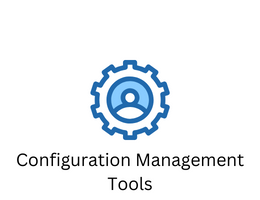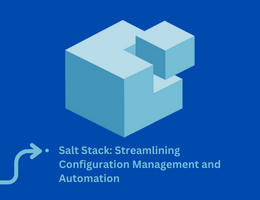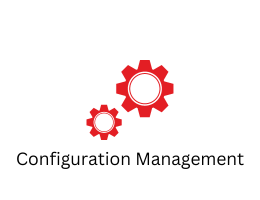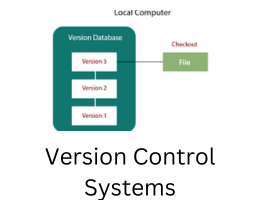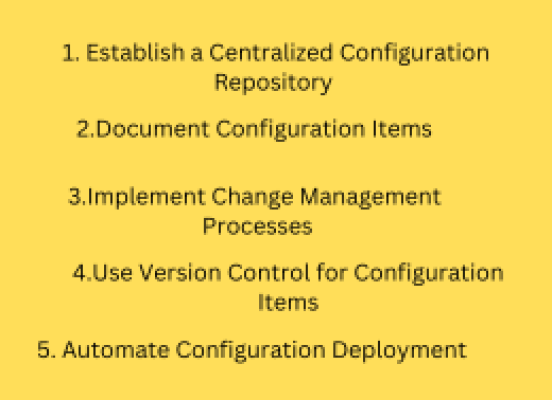
Best Practices for Effective Configuration Management
- By admin --
- Thursday, 01 Jun, 2023
Introduction: Configuration management is a critical aspect of IT infrastructure and software development. It involves managing and controlling the configuration items (CIs) within an organization, including hardware, software, documentation, and network components. Effective configuration management ensures consistency, reliability, and efficiency in systems and reduces risks associated with changes and deployments. In this article, we will explore some best practices that can help organizations establish and maintain effective configuration management processes.
-
Establish a Centralized Configuration Repository: A centralized configuration repository is the backbone of effective configuration management. It provides a single source of truth for all configuration items and facilitates easy access, version control, and collaboration. By storing configurations in a centralized location, organizations can avoid duplicate or conflicting configurations, reduce the risk of errors, and enable efficient tracking of changes. The repository should be well-organized, secure, and easily searchable, allowing authorized personnel to retrieve and update configurations as needed.
-
Document Configuration Items: Accurate and up-to-date documentation is crucial for successful configuration management. Document each configuration item with detailed information, such as its purpose, dependencies, and any specific instructions for setup or maintenance. This documentation should be easily accessible and understandable to all stakeholders involved in the configuration management process. It helps in troubleshooting issues, understanding system interdependencies, and ensures that the correct configurations are deployed consistently across environments.
-
Implement Change Management Processes: Change management is an integral part of configuration management. Establish well-defined processes and workflows to manage and control changes to configuration items. Changes should be requested, reviewed, approved, and implemented systematically, following a standardized change management process. This ensures that changes are properly evaluated for their impact, risks, and dependencies, and are applied in a controlled manner. Regular communication and collaboration among stakeholders, along with proper documentation of change requests and outcomes, are key to maintaining an effective change management process.
-
Use Version Control for Configuration Items: Version control is crucial for tracking and managing changes to configuration items. Implement a version control system that allows you to track and compare different versions of configurations. This enables easy rollback to previous versions if necessary, ensures traceability of changes, and provides an audit trail for compliance purposes. By maintaining a history of configuration changes, organizations can analyze the impact of changes, identify potential issues, and improve overall stability and reliability.
-
Automate Configuration Deployment: Automation plays a vital role in effective configuration management. Implement automated deployment processes and tools to ensure consistent and reliable configuration deployments across different environments. Automation minimizes the risk of manual errors, reduces deployment time, and promotes repeatability. Use configuration management tools that support automation and provide features like configuration drift detection and remediation. Automated deployments also enable organizations to scale their infrastructure and adapt to changing business requirements efficiently.
-
Perform Regular Audits and Reviews: Regular audits and reviews are essential for maintaining the integrity and effectiveness of configuration management processes. Conduct periodic reviews to ensure that configurations are up to date, accurately documented, and aligned with business requirements. Perform audits to validate that the deployed configurations match the intended configurations, identify configuration drift, and rectify any inconsistencies. Audits and reviews help in identifying potential risks, gaps, and areas for improvement, enabling organizations to continuously enhance their configuration management practices.
-
Establish Configuration Baselines: Configuration baselines serve as reference points for configuration management. Establish baselines for different environments, such as development, testing, staging, and production. Baselines capture the approved configurations for each environment and serve as a standard for deployments. Any changes made to the configurations should be compared against the baselines, ensuring that deviations are documented, reviewed, and approved. Baselines provide stability and consistency, making it easier to troubleshoot issues, replicate environments, and ensure reproducibility.
-
Train and Educate Personnel: Invest in training and educating personnel involved in configuration management. Provide comprehensive training on configuration management processes, tools, and best practices. This ensures that the team has the necessary skills and knowledge to perform their roles effectively. Keep personnel updated with the latest advancements in configuration management and encourage continuous learning. Effective communication and collaboration among team members foster a culture of shared responsibility and enable the exchange of ideas and insights.
Conclusion: Implementing best practices for effective configuration management is crucial for organizations to maintain consistency, reliability, and efficiency in their IT infrastructure and software development processes. By establishing a centralized configuration repository, documenting configuration items, implementing change management processes, using version control, automating configuration deployment, performing regular audits and reviews, establishing configuration baselines, and investing in personnel training, organizations can significantly enhance their configuration management practices. Following these best practices will lead to improved system stability, reduced risks, and increased agility in adapting to changing business needs.

